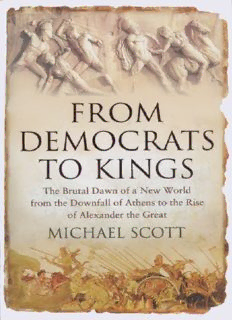
From Democrats to Kings: The Brutal Dawn of a New World from the Downfall of Athens to the Rise of Alexander the Great PDF
Preview From Democrats to Kings: The Brutal Dawn of a New World from the Downfall of Athens to the Rise of Alexander the Great
Copyright This edition first published in hardcover in the United States in 2010 by The Overlook Press, Peter Mayer Publishers, Inc. 141 Wooster Street New York, NY 10012 www.overlookpress.com For bulk and special sales, please contact [email protected] Copyright © 2009 by Dr. Michael Scott All rights reserved. No part of this publication may be reproduced or transmitted in any form or by any means, electronic or mechanical, including photocopy, recording, or any information storage and retrieval system now known or to be invented, without permission in writing from the publisher, except by a reviewer who wishes to quote brief passages in connection with a review written for inclusion in a magazine, newspaper, or broadcast. ISBN 978-1-46830-280-6 Contents Copyright About the author Acknowledgements List of Illustrations Maps Introduction: One Man’s Dream 1 Flute Players and Pick Axes 2 The City of (Crass) Long-Haired Warriors 3 Dancing with the Persian King 4 ‘Serious Business for Tomorrow’ 5 The Vegetarian Philosopher and the Body-Building Philanthropist 6 The Slippery Fish 7 The Clash of Philosopher and Tyrant 8 The Implosion of Greece 9 The Cow’s Bladder, the Love Curse and the Caricature 10 Ten Years That Changed the Ancient World: 362–352 BC 11 Survival Strategies 12 Saviour or Tyrant? 13 The Final Showdown 14 From Father to Son 15 Ruling the Ancient World 16 You’ve Never Had it So Good 17 A New World Epilogue: From Democrats to Kings Select Bibliography Timeline Index About the author MICHAEL SCOTT is currently a Moses and Mary Finley Fellow in Ancient History at Darwin College, Cambridge, where he studies the ancient Greek and Roman worlds as well as teaching undergraduates and working with schools around the country. Since 2007, he has been a regular guest lecturer aboard cruise tours of ancient Greece, has run the route of the ancient Marathon in Athens, and has been an on-screen historical consultant for several documentaries about the ancient world for the History Channel. www.michaelcscott.com For Peter Wicker, who taught me my first letters of the ancient Greek alphabet Acknowledgements The genesis of this book was in a series of lectures given to undergraduates at Cambridge University. My thanks go to the class of students who attended those lectures with good humour and grace, who gave me an opportunity to road test my ideas and who gave much helpful feedback. To the many friends and colleagues with whom I have enjoyed countless discussions about the subject of this book and about the ancient world in general, I offer my sincerest gratitude. I would especially like to thank Prof. Robin Osborne, Prof. Paul Cartledge, Prof. Pat Easterling, Dr Alastair Blanshard, James Watson, Ben Keim, Peter Agocs, Clare Killikelly and Kelly Agathos for their thoughts, wit and guidance. To the small team of ‘veteran travellers’ who willingly came with me to explore the ‘dancing floor of Ares’, its mysteries and delights (not least of which was the underrated modern town of Thebes), I say ‘Suga!’ To Davina Barron, who carefully and helpfully read earlier drafts, I offer my indebted thanks. To Darwin College, Cambridge and to the British School at Athens, two admirable research institutions, which have made me feel very much at home in Cambridge and Athens not just during the research and writing of this book but over the past several years, I offer my heartfelt gratitude and praise. To the people who make these two institutions what they are, and who are themselves so much more besides, I give my admiration and affection. To Moses and Mary Finley, towering greats in the scholarship of the ancient world, whose legacy funds my current position as Finley Research Fellow at the University of Cambridge, I offer my continued awe and thanks. For good advice on entering the world of history writing, my deepest appreciation goes to my agents Diane Banks and Sue Rider, my editor at Icon Simon Flynn, Duncan Heath and the rest of the team at Icon, and at Cambridge Prof. Mary Beard, Prof. Simon Goldhill and Dr Chris Kelly. Finally, to my family, who encouraged my desire to pursue this crazy classics thing many years ago: thank you. It has been a pleasure and an honour to write this book and to help bring the ancient world once more to life. List of Illustrations Maps Map 1: Athens and Piraeus Map 2: Greece, the Aegean and the Asia Minor coast Map 3: Megale Hellas Map 4: Alexander the Great’s empire Plate section 1. An ancient portrait bust of Alexander the Great. 2. The Pnyx hill in the centre of Athens (with the Acropolis and Parthenon in the background). 3. The public graveyard of Athens, the Cerameicus. 4. The landscape of the ancient city of Sparta. 5. A reconstruction of the ancient sanctuary of Delphi. 6. A reconstruction of the ancient sanctuary of Olympia. 7. The Theban victory monument at Leuctra. 8. The remains of the wall built by the Athenians to protect Attica. 9. A Roman copy of the statue of Eirene and Ploutus, 4th century BC. 10.A Roman copy of the Aphrodite of Cnidus. 11.A recreation of Mausolus’ funeral Mausoleum. 12.The law for the protection of democracy in Athens, 338 BC. 13.The stone lion set up by King Philip of Macedon at the battlefield of Chaeronea. 14.The temple and oracle of the god Ammon at Siwah. 15.The remains of the great Persian capital of Persepolis. 16.The Tyrannicides statue group. Map 1
Description: